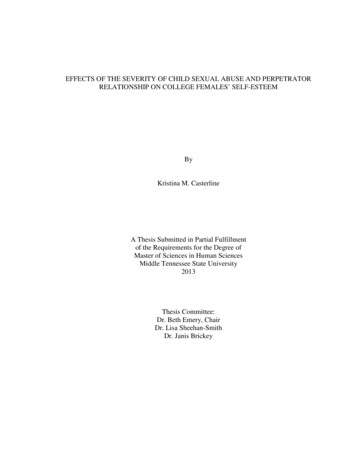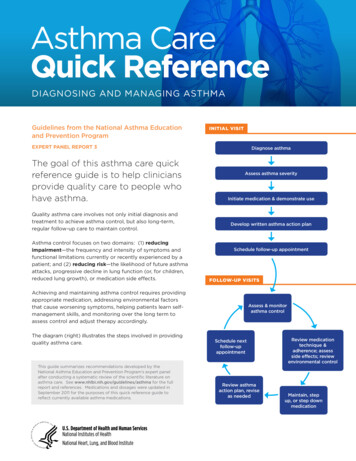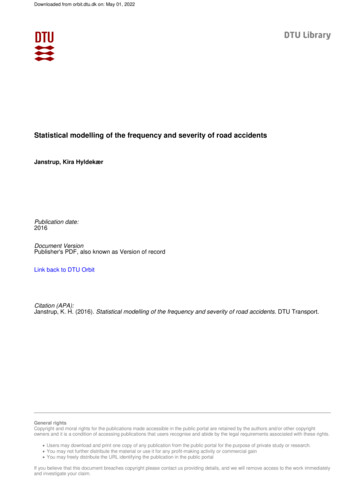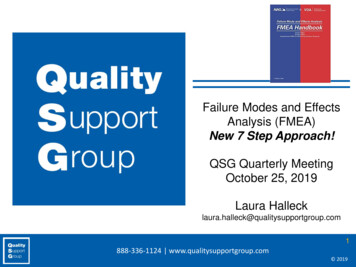
Transcription
EFFECTS OF THE SEVERITY OF CHILD SEXUAL ABUSE AND PERPETRATORRELATIONSHIP ON COLLEGE FEMALES’ SELF-ESTEEMByKristina M. CasterlineA Thesis Submitted in Partial Fulfillmentof the Requirements for the Degree ofMaster of Sciences in Human SciencesMiddle Tennessee State University2013Thesis Committee:Dr. Beth Emery, ChairDr. Lisa Sheehan-SmithDr. Janis Brickey
ACKNOWLEDGEMENTSI would like to extend my gratitude to my daughter who has been a support to mein my education. She has sacrificed much of her own needs because of this goal I’ve hadof earning a Master’s degree. I hope I have instilled in you the value of hard work anddedication in whatever area of life God takes you. I am also grateful to my other familymembers who have continued to encourage me.I am also very appreciative to my fellow employees and all of the support,encouragement and listening ears they have provided in this journey of college, work,and family. You have stood by me and watched as I have taken class after class andlistened to me share about each challenge I have faced. I am grateful to work with such ahard working staff.To the professors that have not only taught me over these 4 years of college butfor the ones who have graciously agreed to be on my committee. Thank you for yourtime, talent and expertise in the feedback given and helping me stay on the right track inmy thesis studies. Your guidance has been very much needed and appreciated.To my fellow graduate student classmates that have shared their insight,frustrations and helped motivate me to finish this work; I owe a huge thanks to you.i
ABSTRACTChild sexual abuse (CSA), perpetrator characteristics and self-esteem were studied usingan extant data set comprised of a subsample of 177 college females. It was hypothesizedthat there would be a difference in the severity of CSA based on the identity of theperpetrators (i.e., other children, adults, or both children and adults) and the perpetratorrelationship to the victim. Results indicated that the CSA was more severe amongchildren who were abused by both a child and an adult. No significant results were foundregarding the relationship of the perpetrator to the victim. The second hypothesis soughtto determine if there were differences in CSA victims’ levels of self-esteem based onperpetrator identity and relationship to the victim. No differences were found in levels ofself-esteem based on identity of perpetrator or relationship to the victim. Attachmenttheory was used to discuss the effects of CSA on victims.ii
TABLE OF CONTENTSPageCHAPTER 1: INTRODUCTION .1Theoretical Overview .3Statement of Research Questions .4Definition of Terms .4CHAPTER 2: REVIEW OF THE LITERATURE .8Definitions of Abuse and Child Sexual Abuse . . . .8Incident Rates for Child Abuse and Child Sexual Abuse . .11Victimization by gender . .13Family and Non-family Perpetrators . . .16Sibling sexual abuse . .18Effects of Child Sexual Abuse . . 19Disclosure and Later Adjustment . .22Self-esteem . .24Effect of child sexual abuse on self-esteem . . 26Traumagenic dynamics model 27Sexuality . .29Attachment Theory . . .31Attachment patterns .32Family dynamics . .33Affect regulation . .36iii
Conclusion .38Statement of Hypotheses 39CHAPTER 3: METHODS .40Subjects . .40Instruments .40The child sexual abuse questionnaire . .41Rosenberg self-esteem scale . . 42Procedure for Data Collection .43Statistical Analysis . .43CHAPTER 4: RESULTS . . .46Hypotheses . 46Post Hoc Analysis . .48CHAPTER 5: DISCUSSION .50Findings . .50Perpetrator Impact on Self-Worth and Self-Efficacy.51Perpetrators’ relationship to the victim . .51Perpetrators’ identity . . .54Perpetrator Impact on Level of Severity of Child Sexual Abuse . .56Perpetrators’ relationship to the victim .56Perpetrators’ identity . .57Conclusions . 59Limitations .60Implications for Research 60iv
Implications for Practice .61REFERENCES 64APPENDICIES 70APPENDIX A: IRB APPROVAL LETTER .71APPENDIX B: CONSENT FORM 72APPENDIX C: QUESTIONAIRE .73
List of TablesTable 1: Impact of Perpetrator Identity on Self-Esteem . 52Table 2: Impact of Perpetrator Relationship on Self-Esteem .56v
1CHAPTER IIntroductionChild abuse has an impact on all of us within society, from negative mediaattention such as in the case of child molester Jerry Sandusky, Penn State Universityfootball coach, to the lives of numerous children and families that have been traumatizedas a result of sexual abuse. The recent conviction of Jerry Sandusky for 45 counts ofsexual abuse of children brings much criticism and contempt in the public’s eye(Wolverton, 2012). This event has brought greater awareness of the occurrence of childsexual abuse in society as well as the severe consequences for individuals, families andcommunities.Due to the number of university officials that failed to report the abuse; thisnational scandal has led to ongoing investigations and indictments of their failure toreport child abuse within the collegiate athletic community (Wolverton, 2012). Theofficials had suspicions that sexual behaviors were occurring for over 14 years, but hadnot followed through with mandatory reporting laws (Wolverton, 2012). Because theofficials did not have evidence they did not report, however, there only has to besuspicion of abuse to make a report. Child abuse cases are investigated by childprotective services in order to establish the evidence if abuse has actually occurred. Thisis an area that the public now has knowledge of if they did not know beforehand, due tothis national example of failure to report crimes against children. Penn State officials arerethinking their culture in order to create an open climate for people to truly protect
2children from abuse by reporting immediate suspicions to those in authority (Wolverton,2012).Child sexual abuse (CSA) is a category of abuse along with other types, such asphysical and emotional abuse, as well as neglect. In 2010, the national rate of abuse wasabout 9.2 victims per 1,000 children (USDHHS, 2008). CSA may not be reported asprevalently as physical abuse, but is usually co-occurring with other types of abuse. Itremains a hidden problem in many cases because people do not report it as frequently asphysical abuse or neglect. CSA has serious effects on children. Mostly, the effects arediscussed as they relate to physical, emotional, social and mental health. Factors thatdetermine the resiliency of the child in overcoming the abuse are related to the frequency,intensity, and duration of the abuse as well as other factors such as the relationshipbetween the child and the perpetrator, and the age and developmental level of the childwhen the abuse occurred. Girls are more likely to be abused by family members, andboys are more likely to be abused by strangers (Finkelhor, et al.,1990). Sibling sexualabuse is a growing area of research and is drawing more attention. According to Ruddand Herzberger (1999) sibling sexual abuse occurs more frequently than any other formof sexual abuse.Examining the support systems within the child’s life is critical in understandinghow these systems impact the child and offset any negative effects from the CSAexperienced. Caregivers who are more supportive tend to have greater levels ofattachment to the child, whereas a guardian who is close to the perpetrator is less likely tobe supportive of the victim (Yancey & Hansen, 2010). Self-esteem is another variable to
3consider in determining the harmful effects of CSA. Low self-esteem is said to increasethe likelihood of psychiatric conditions developing and is most commonly associatedwith depression in the DSM-IV (Fassler, Ameodeo, Griffin, Clay, and Ellis, 2005). Inthinking about ways to help the victims, it is suggested that child sexual abuse treatmentprograms be aimed at strengthening children’s self-efficacy can greatly impact theirlikelihood of lessening internalized symptomatology among preschool and earlyelementary school- aged children (Kim & Cicchetti’s, 2003). CSA can have a long termimpact on victims in many areas of their lives including self-esteem (Finkelhor &Browne, 1985).The purpose of this study is to examine the effects of child sexual abuse onfemale adult’s self-esteem. Also, it will be determined who the perpetrators of abuse areand what the characteristics of that abuse looks like in terms of severity. An empiricalreview of the research on child sexual abuse and attachment will be used as thetheoretical framework.Theoretical OverviewAttachment theory, proposed by Bowlby and Ainsworth, (1973) consists ofpatterns of interaction that precipitate healthy development into adulthood. A childdevelops secure or insecure attachments to their caregiver based on multiple interactionswith that caregiver. These interactions provide the basis of the child’s ability to trust andinteract with others interpersonally. Healthy attachment is characterized by a secureattachment whereas an unhealthy pattern is adverse to the child’s development and is
4characterized by an anxious or avoidant pattern of behavior. Childhood trauma, such aschild sexual abuse could play a role in how healthy and unhealthy attachment patternsdevelop (Bowlby & Ainsworth, 1973).Statement of Research QuestionsThe following research questions have been developed for the purpose of this study.1. What is the prevalence of child sexual abuse by other children as the perpetratoramong a sample of college females?2. What is the prevalence of both CSA by an adult perpetrator among a sample ofcollege females?3. What is the prevalence of CSA by both a child and an adult perpetrator among asample of college females?4. Are the perpetrators family or non-family members?5. What is the gender of the perpetrators?Definition of TermsAttachment Theory: developed by John Bowlby (1969, 1973) refers to a child's earlyexperience of being nurtured and developing a bond with a caring adult that affects allaspects of behavior and development.Child Protective Services: within the State of Tennessee, (CPS) is the state agency thatoversees the reports of abuse and neglect for children.
5Child Sexual Abuse: (CSA) Finkelhor (1986) defined CSA as any exposure to sexualactivity, regardless of age difference, and forced or coerced sexual behavior imposed on achild and sexual activity between a child and a much older person, (at least 5 years)whether coercion is obvious or not.Duplicate Victim: The duplicate count of child victim’s counts a child each time he orshe was found to be a victim (USDHHS, 2008).External symptoms of CSA: aggression, antisocial, and undercontrolled behavior(Kendall-Tackett, et al., 1993).Incest: sexual intercourse between persons so closely related that they are forbidden bylaw to marry. Retrieved on August 7, 2012 from www.dictionary.reference.com.Internal symptoms of CSA: withdrawn behavior, depression, fearfulness, inhibition,and overcontrol (Kendall-Tackett, et al., 1993).Perpetrator: the person who is responsible for the abuse or neglect of a child (USDHHS,2008).Post -Traumatic Stress Disorder: (PTSD) a mental disorder occurring after a traumaticevent outside the range of usual human experience, and characterized by symptoms suchas reliving the event, reduced involvement with others, and manifestations of autonomicarousal such as hyperalertness and exaggerated startle response. Retrieved on August 7,2012 from www.dictionary.reference.com.
6Self-efficacy: According to Albert Bandura, self-efficacy is a person’s belief in his or herability to succeed in a particular situation. Bandura described these beliefs asdeterminants of how people think, behave, and feel (1994).Self-esteem: an attitude toward the self whereby each characteristic of the self isevaluated according to a value that has developed during childhood and adolescence(Guindon, 2010).Self-worth: the amount of self-acceptance or self-approval individuals have forthemselves.Substantiated- an incident of child abuse or neglect, as defined by State law, is believedto have occurred. Retrieved on August 7, 2012 from Child Welfare Information k.cfm.Traumagenic Dynamic Model: a model developed by Finkelhor and Browne (1985)which includes four dynamics that are used to explain the effects of CSA. They aretraumatic sexualization, stigmatization, betrayal, and powerlessness. They definetraumatic sexualization as a result of child sexual abuse where through a developmentalprocess a child’s sexuality is shaped inappropriately and results in interpersonaldysfunction.Unique Victim: The unique count is when the child is only counted once no matter howmany times a report was received (USDHHS, 2008).
7Victim: a person who suffers from a destructive or injurious action or agency (USDHHS,2008).
8CHAPTER IIReview of LiteratureThe literature review analyzed information from a variety of research includingboth government prevalence rates and empirical research. The literature review examinedhow child sexual abuse (CSA) is defined by a variety of sources and how prevalencerates are reported to the public. A review of the effects of CSA on a person’s self-esteemwas also addressed. Personal and psychological developmental factors that contribute to ahealthy psychological and personal well-being were discovered. Lastly, attachmenttheory was discussed as a framework for learning about how family dynamics areimpacted when CSA exists both within the family context and outside of the family unit.Definitions of abuse and child sexual abuseCSA is a part of the greater scope of child abuse but cannot be compared to physical,emotional abuse or neglect. There has been a large amount of research regarding theprevalence of child sexual abuse and its impact on children who have experienced it. TheChild Welfare Information Gateway suggests that sexual abuse is a type of maltreatmentthat refers to the involvement of the child in sexual activity to provide sexual gratificationor financial benefit to the perpetrator, including contacts for sexual purposes, molestation,statutory rape, prostitution, pornography, exposure, incest, or other sexually exploitativeactivities.
9The Child Abuse Prevention and Treatment Act (CAPTA), (42 U.S.C. §5101), asamended by the CAPTA Reauthorization Act of 2010, which retains the existingdefinition of child abuse and neglect as at a minimum:“Any recent act or failure to act on the part of a parent or caretaker whichresults in death, serious physical or emotional harm, sexual abuse orexploitation; or an act or failure to act, which presents an imminent risk ofserious harm.”Another more complex, thorough definition developed and enacted by The Stateof Tennessee enacted Citation: Ann. Code § 37-1-602 defines child sexual abuse as thecommission of any act involving the unlawful sexual abuse, molestation, fondling, orcarnal knowledge of a child under age 13, including: Aggravated rape, sexual battery, or sexual exploitation of a minor Criminal attempt for any of the offenses listed above Especially aggravated sexual exploitation of a minor Incest Rape, sexual battery, or sexual exploitation of a minor Any penetration, however slight, of the vagina or anal opening of one person bythe penis of another person, whether or not there is the emission of semen Any contact between the genitals or anal opening of one person and the mouth ortongue of another person Any intrusion by one person into the genitals or anal opening of another person,including the use of any object for this purpose Intentional touching of the genitals or intimate parts, including the breasts, genitalarea, groin, inner thighs, and buttocks, or the clothing covering them, of either thechild or the perpetrator Intentional exposure of the perpetrator's genitals in the presence of a child, or anyother sexual act intentionally perpetrated in the presence of a child, if such
10exposure or sexual act is for the purpose of sexual arousal or gratification,aggression, degradation, or other similar purpose Sexual exploitation of a child, which includes allowing, encouraging, or forcing achild to solicit for or engage in prostitution or engage in sexual exploitationHowever, most studies categorize CSA on the basis of other factors. For example, areview of empirical research by Kendall-Tackett, Williams-Meyer, Finkelhor (1993)confer that abuse severity is used to explain the type of abuse the victim experienced. Inother words, CSA would be classified as severe if penetration was involved and sexualabuse that involves no physical contact would be considered less severe. Examples of thelatter would be perpetrator exposure, sexual talk, and viewing pornography. Otherconsiderations regarding the severity of abuse include the use of threat or force, weapons,and physical abuse (Paolucci, Genuis, and Violato, 2001). Beitchman, Zucker, Hood,daCosta, and Akman (1991) stated that the more severe the abuse, the more severe thesymptoms of the abuse.Obviously, these definitions differ in their detail, scope, and breadth, which make itdifficult to distinguish between the types of CSA and/or to compare incidence andprevalence rates. Adding to this confusion is the fact that studies of various forms andaspects of child abuse rely on definitions that differ in their perspectives resulting infragmented rather than comprehensive analysis of CSA incidence and outcomes. Thecurrent research proposal utilizes Finkelhor’s 1986 definition of CSA that consists of twotypes of interaction. Finkelhor (1986) defined CSA as forced or coerced sexual behaviorimposed on a child and sexual activity between a child and a much older person, (at least5 years) whether coercion is obvious or not (Finkelhor, 1986). For purposes of this
11research proposal, the severity of abuse will be categorized by low, medium and highlevels of intensity and frequency. These are further defined in the methodology chapter.Incidence Rates for Child Abuse and Child Sexual AbuseAs stated previously, one concern with current statistics is the differences in theway abuse is reported, defined, and collected. Due to the variations of reporting methodsin the child welfare system, we cannot truly get an accurate picture of the scope of childabuse in America. According to the United States Department of Health and HumanServices in 2008, the rate of substantiated reports of child abuse was approximately 10per 1,000 children ages zero to seventeen. Younger children are more frequently victimsof child abuse than older children. There were 22 substantiated child abuse reports per1,000 children under age one, compared with 12 for children ages one to three, 11 forchildren ages four to seven, nine for children ages eight to 11, eight for children ages 1215, and 5.5 for adolescents ages 16-17 (USDHHS, 2008). In 2010, also reported by theUnited States Department of Health and Human Services, approximately 3.3 millionreports of suspected abuse pertaining to six million children were made in the UnitedStates. Some of these reports are the result of duplicate children being reported. In 2010,19 % of reports were substantiated, 63 % were unsubstantiated, and one percent hadindicated abuse (USDHHS, 2010).All 52 states submitted data to the National Child Abuse and Neglect Data System(NCANDS) about the dispositions of children who received one or more child protectiveservices responses. For 2010, more than 3.6 million (duplicate) children were subjects of
12at least one report and received one or more dispositions. Fifty states reported the totalduplicate count of perpetrators as 891,218 and the total unique count of perpetrators as510,824. The duplicate count of child victim’s counts a child each time he or she wasfound to be a victim. The unique count is when the child is only counted once no matterhow many times a report was received. For the analysis included in this report, aperpetrator is the person who is responsible for the abuse or neglect of a child. To breakdown the information further, Child Protective Services investigations or assessmentsdetermined that for unique victims 78.3% suffered neglect, 17.6% suffered physicalabuse, and 9.2 percent suffered sexual abuse (NCANDS, 2010). More than two-fifths(45.2%) of unique perpetrators were men and more than one-half (53.6%) were women.More than one-third (36.3%) of unique perpetrators were in the age group of 20–29 years.More than 80 percent (84.2%) of unique perpetrators were between the ages of 20 and 49years (NCANDS, 2010).These incidence rates demonstrate that the issue of child abuse is still an ongoingissue because there has not been much variation in the number of children affectedthroughout the reporting years. This research proposal is designed to answer questions asto the severity of CSA based upon a sample, both with interfamilial and non-interfamilialperpetrators, in order to closely analyze the effects of abuse on a person’s self-esteem.Future implications include looking at how family members and other people in thechild’s life can contribute to minimizing the impact of CSA on the child and family. Bylooking closely at each of these variables, it can help educate the public about the true
13face of CSA, help others identify the experiences and symptoms of CSA, and contributeto the healing process for them and their families.Victimization by gender. Victims in the age group of birth to one year had thehighest rate of victimization at 20.6 per 1,000 children of the same age group in thenational population. Victimization was split between the sexes, with boys accounting for48.5 % and girls accounting for 51.2 %. Fewer than one percent of victims had anunspecified sex (NCANDS, 2010). These prevalence rates demonstrate the significanceof the problem and the necessity of further research in the area of CSA. In a nationallyrepresentative study by Basile, Chen, Lynberg and Saltzman (2007), 60% of female and69% of male victims were first raped before age 18. A quarter of females were first rapedbefore age 12, and slightly more at 34% were raped between the ages of 12 and 17. Malesbefore age 12 encountered their first rape at 41%, and 27% between the ages of 12 and17. A common pattern for adolescents who offend against peers or adults is that they tendto choose female victims, and the group of adolescents who sexually offend youngerchildren, including sibling offenders, choose female, male or both genders as victims(Worling, 2001).In a phone study conducted by Finkelhor, Hotaling, Lewis, and Smith (1990),1,145 men and 1,481 women were asked questions about sexual experiences thatoccurred during childhood (before age 18). Sixteen percent of men (n 169) and 27% ofwomen (n 416) disclosed sexual abuse. The median age of abuse was 9.9 for boys and9.6 for girls. Boys were more likely to be abused by strangers (40%) and girls were morelikely to be abused by family members (29%). For both girls and boys, they were both
14victimized mainly by men at 83% for boys and 98% for girls. Force was used in only15% with boys and 19% with girls. Most events only occurred once. There was a smallnumber of peer abuse. There was no significant difference in abuse duration between thegenders. It is interesting to note that boys were somewhat more likely to never havedisclosed the abuse (Finkelhor, et al., 1990).Finkelhor & Dziuba-Leatherman (1994) conducted a telephone study involvingtwo thousand children aged 10-16 years old. Of these, 3.2 % of girls and .6 % of boyssuffered from contact sexual abuse. Contact incidents were defined as a person touchingthe sexual parts of a child, penetrating the child, or having any oral-genital contact withthe child. A little less than half of the sexual assaults were perpetrated by other juveniles,16 % by family members and 72 % by nonfamily members. There were more reportsfrom boys concerning violence to genitals than contact sexual abuse. It was reported thatgirls were at a higher risk of attempted and completed kidnapping being perpetrated byadults for the purpose of sexual assault. Boys were at a higher risk of nonfamily/peerassault directed at the genitals.Lynskey and Fergusson (1997) used data from an 18 year longitudinal studywhere CSA victims were interviewed at length about their sexual abuse experiences priorto age 16. Sexual experiences ranged from contact to noncontact. Contact episodesconsisted of sexual fondling, genital contact, and attempts to undress the respondent, aswell as incidents of attempted or completed oral, anal, or vaginal intercourse. Noncontactepisodes consisted of indecent exposure, public masturbation, and unwanted sexualattention. Victims were asked about the age in which abuse occurred, number of events,
15duration of abuse, types of abuse, if physical restraint was used, if the victim consideredit abuse at time of incident, characteristics of perpetrator, relationship, if abuse wasdisclosed, and whether they had sought counseling. Results of the study showed that only17 males reported CSA, so both males and females were combined to equal 107 totalpersons who reported CSA. Of these, 14% were abused before the age of five; 29% wereabused between six and ten years of age and 57% were abused between the ages of 11 to16 years of age. Of the sample, 47.7% reported that the abuse involved physical restraintor violence; 22.4% reported noncontact abuse, 43.9% involved contact but not attemptedor completed intercourse; and 33.7% involved contact with completed vaginal, oral oranal intercourse. Parents or sibling perpetrators were 15%; 13.1% by another relative;53.3% abused by someone they hardly knew; and 32.7% by a stranger. Some involvedmultiple perpetrators (Lynskey and Fergusson, 1997).Ullman’s (2007) sample of mostly female college students reported less than22.8% of CSA. Of that sample, 66.5% of these experienced multiple incidents andinvolved attempted or completed penetration. Students were abused by knownperpetrators 89.4% of the time and only 10.6% had encounters with strangers. Familymembers were the perpetrators 37.8% of the time, 28.2% were neighbors, and 13.5%were friends. Both men and women were likely to be sexually abused if they alsoreported that their family life was unhappy and their family situation consisted of onenon-biological parent. This could be due to the parents providing limited supervision andattention, therefore creating increased vulnerability for the child (Finkelhor, et al., 1990).
16There are a few consistent differences in the reaction of boys and girls to CSA.The lack of these findings is in contrast to the popular belief that boys are likely tomanifest externalized symptoms and girls are more likely to exhibit internalizedsymptoms. Internalizing symptoms are withdrawn behavior, depression, fearfulness,inhibition, and over control. Externalizing symptoms are aggression, antisocial, and undercontrolled behavior (Kendall-Tackett, et al., 1993).The missing data on consistent genderdifferences are remarkable because girls are more likely to suffer from interfamilialabuse, which is associated with more severe effects (Finkelhor, et al., 1990).Family and Non-family PerpetratorsIn a nationally representative study by Basile, Chen, Lynberg and Saltzman(2007), female victims were most likely to report having been sexually abused byintimate partners at 30%, abuse by family members at 23%, and by acquaintances at20%. Meiselman (1978) found that several female children were abused in 15% of casesof father-daughter incest. There was a 50% more likelihood of sexual approaches beingmade toward other female victims in the home. Stern, Lynch, Oates, O’Toole, andCooney (1995) reports that nonfamily members tend to abuse victims in shorter durationsand frequencies. In addition, victims are slower to disclose when a family member is theperpetrator.Kendall-Tackett et al.,(1993) purports that the closer the relationship betweenperpetrator and victim, the greater the impact is on the child. Severity of abuse should notbe determined by family relationship alone because it is possible that children can have a
17closer relationship to non-family members than family members. For example, justbecause a father is in the home does not make him stronger in relationship to the victim.He may not have a strong attachment to the child and therefore, would not be a decidingfactor in determining the effect of the abuse just because of having the title of father.Although Beitchman et al., (1991) showed that those abused by fathers or step-fatherswere more likely to exhibit trauma symptoms than those abused by others. Abuse byrelatives was more severe, began at a much younger age, lasted longer, and resulted ingreater PTSD symptoms than abuse by strangers or someone hardly known. Thoseabused by relatives also reported more emotional closeness to the perpetrator both beforeand after the abuse (Ullman, 2007).A bias exists that assumes fathers will only abuse daughters. There is a chancethat the father may cross genders and become an abuser to b
physical and emotional abuse, as well as neglect. In 2010, the national rate of abuse was prevalently as physical abuse, but is usually co-occurring with other types of abuse. It remains a hidden problem in many cases because people do not report it as frequently as physical abuse or neglect. CSA has serious effects on children.










